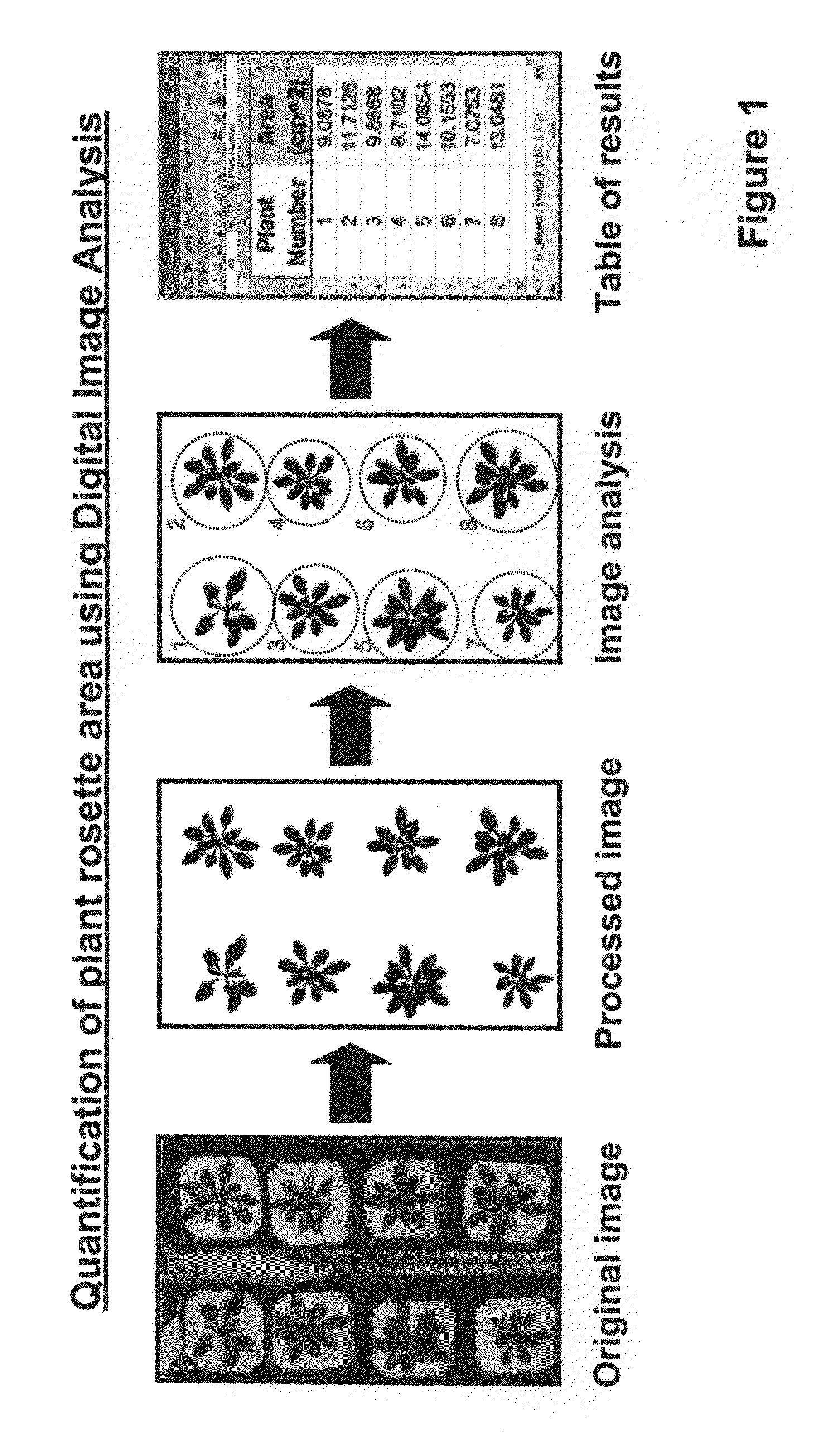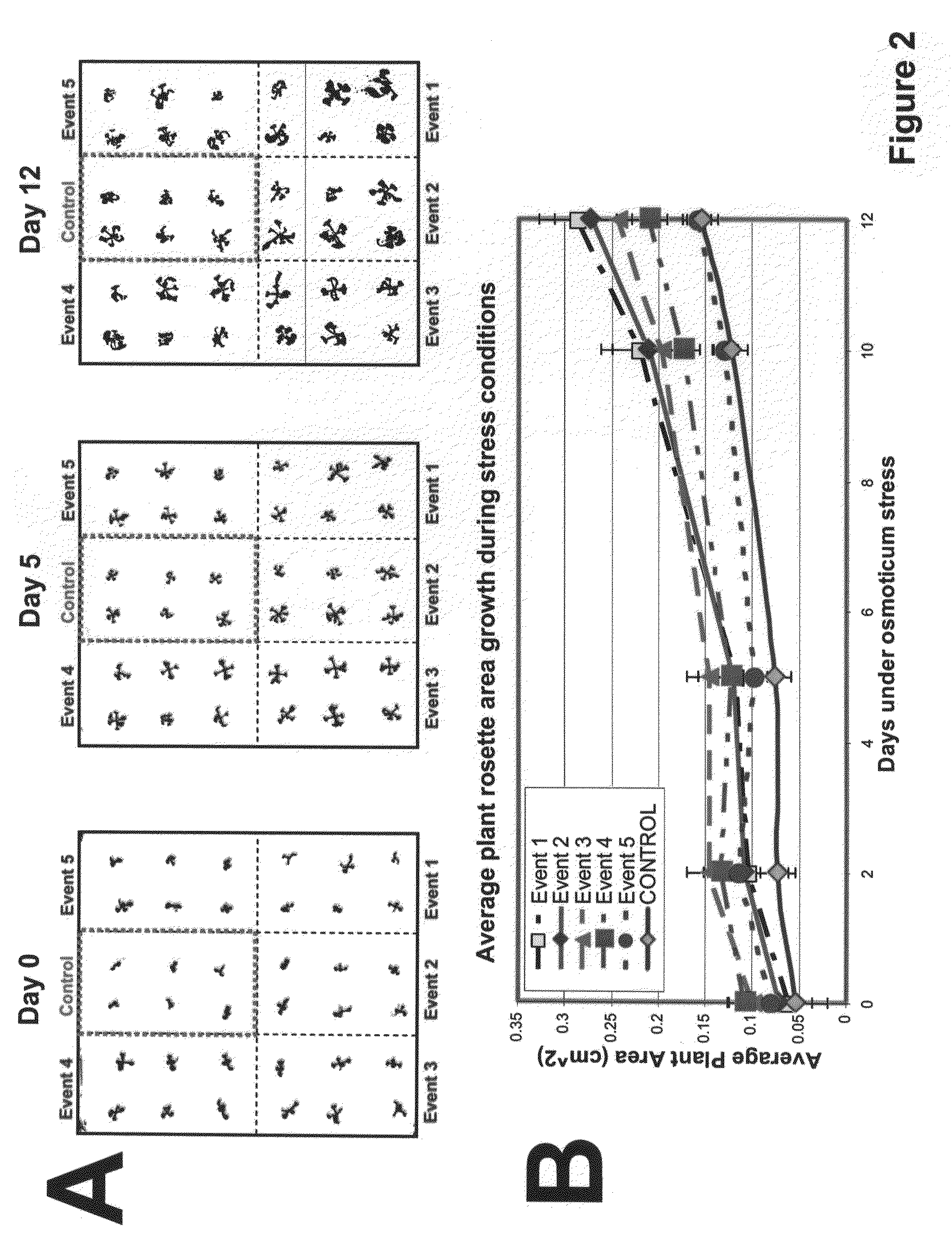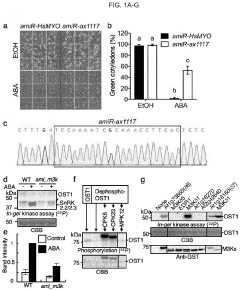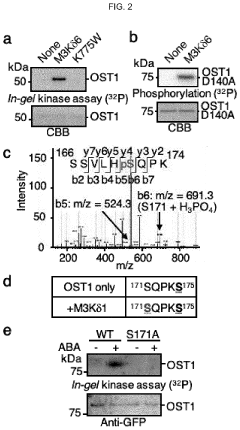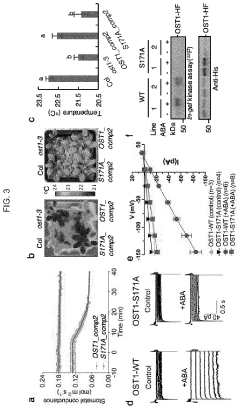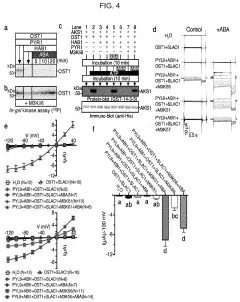How to Boost Crop Resilience with Abscisic Acid Modulation?
JUL 14, 20259 MIN READ
Generate Your Research Report Instantly with AI Agent
Patsnap Eureka helps you evaluate technical feasibility & market potential.
ABA Modulation Background and Objectives
Abscisic acid (ABA) is a plant hormone that plays a crucial role in regulating plant responses to various environmental stresses, particularly drought and salinity. The modulation of ABA signaling has emerged as a promising approach to enhance crop resilience in the face of increasingly unpredictable and extreme weather conditions caused by climate change. This technological focus aims to develop innovative strategies for manipulating ABA pathways to improve crop performance under adverse conditions.
The history of ABA research dates back to the 1960s when it was first identified as a plant growth inhibitor. Since then, our understanding of its functions and signaling mechanisms has grown exponentially. ABA is now recognized as a key player in stomatal closure, seed dormancy, and plant stress responses. The evolution of ABA-related technologies has progressed from basic physiological studies to advanced molecular and genetic approaches, including the development of ABA-responsive synthetic promoters and the engineering of ABA receptors.
Recent advancements in genomics, proteomics, and metabolomics have further accelerated our ability to manipulate ABA pathways. The discovery of the PYR/PYL/RCAR family of ABA receptors in 2009 marked a significant milestone, opening new avenues for targeted interventions in ABA signaling. This breakthrough has led to the development of ABA agonists and antagonists, providing powerful tools for fine-tuning plant stress responses.
The primary objective of ABA modulation research is to enhance crop resilience without compromising yield or quality. This involves developing strategies to optimize ABA responses, such as improving water use efficiency, enhancing drought tolerance, and maintaining photosynthetic capacity under stress conditions. Additionally, researchers aim to exploit ABA-mediated mechanisms to improve seed germination, seedling establishment, and overall plant vigor.
Another critical goal is to create crops that can rapidly and efficiently activate stress response mechanisms when exposed to adverse conditions, while maintaining normal growth and development under favorable conditions. This "priming" approach seeks to enhance the plant's ability to anticipate and respond to stress, potentially reducing the need for external interventions such as irrigation or pesticide application.
The technological trajectory in ABA modulation is moving towards more precise and targeted approaches. This includes the development of tissue-specific and stress-inducible ABA modulation systems, as well as the integration of ABA signaling with other stress response pathways. The ultimate aim is to create "smart" crops that can dynamically adjust their physiology in response to changing environmental conditions, thereby ensuring food security in the face of climate change.
The history of ABA research dates back to the 1960s when it was first identified as a plant growth inhibitor. Since then, our understanding of its functions and signaling mechanisms has grown exponentially. ABA is now recognized as a key player in stomatal closure, seed dormancy, and plant stress responses. The evolution of ABA-related technologies has progressed from basic physiological studies to advanced molecular and genetic approaches, including the development of ABA-responsive synthetic promoters and the engineering of ABA receptors.
Recent advancements in genomics, proteomics, and metabolomics have further accelerated our ability to manipulate ABA pathways. The discovery of the PYR/PYL/RCAR family of ABA receptors in 2009 marked a significant milestone, opening new avenues for targeted interventions in ABA signaling. This breakthrough has led to the development of ABA agonists and antagonists, providing powerful tools for fine-tuning plant stress responses.
The primary objective of ABA modulation research is to enhance crop resilience without compromising yield or quality. This involves developing strategies to optimize ABA responses, such as improving water use efficiency, enhancing drought tolerance, and maintaining photosynthetic capacity under stress conditions. Additionally, researchers aim to exploit ABA-mediated mechanisms to improve seed germination, seedling establishment, and overall plant vigor.
Another critical goal is to create crops that can rapidly and efficiently activate stress response mechanisms when exposed to adverse conditions, while maintaining normal growth and development under favorable conditions. This "priming" approach seeks to enhance the plant's ability to anticipate and respond to stress, potentially reducing the need for external interventions such as irrigation or pesticide application.
The technological trajectory in ABA modulation is moving towards more precise and targeted approaches. This includes the development of tissue-specific and stress-inducible ABA modulation systems, as well as the integration of ABA signaling with other stress response pathways. The ultimate aim is to create "smart" crops that can dynamically adjust their physiology in response to changing environmental conditions, thereby ensuring food security in the face of climate change.
Market Analysis for Resilient Crop Solutions
The market for resilient crop solutions is experiencing significant growth, driven by increasing global food demand and the challenges posed by climate change. Abscisic acid (ABA) modulation presents a promising avenue for enhancing crop resilience, with potential applications across various agricultural sectors.
The global agricultural biotechnology market, which encompasses crop resilience solutions, is projected to reach substantial value in the coming years. This growth is fueled by the need for sustainable farming practices and the rising adoption of genetically modified crops. Within this market, ABA-based solutions are gaining traction due to their ability to improve plant stress tolerance and water use efficiency.
Geographically, North America and Europe currently lead the market for advanced crop resilience technologies, including ABA modulation. However, emerging economies in Asia-Pacific and Latin America are expected to witness rapid growth in adoption rates as they seek to bolster their agricultural productivity and food security.
The demand for ABA-based crop resilience solutions is particularly strong in regions prone to drought, salinity, and extreme temperatures. As climate change exacerbates these environmental stressors, farmers are increasingly looking for innovative ways to protect their yields and ensure crop survival under adverse conditions.
Key market segments for ABA modulation technologies include major staple crops such as wheat, rice, and maize, as well as high-value horticultural crops. The fruit and vegetable sector, in particular, shows significant potential for ABA applications due to the crops' sensitivity to environmental stresses and the high economic value of improved resilience.
Market analysis indicates that large-scale commercial farmers are the primary early adopters of ABA-based technologies. However, there is growing interest from smallholder farmers, especially in developing countries, as more affordable and accessible solutions become available.
The competitive landscape for resilient crop solutions is characterized by a mix of established agrochemical companies and innovative biotechnology startups. Major players are investing heavily in research and development to create proprietary ABA modulation techniques and formulations.
Regulatory frameworks play a crucial role in shaping the market for ABA-based crop resilience solutions. As these technologies often involve genetic modification or novel biochemical approaches, navigating regulatory approval processes is a key factor in market entry and expansion.
Consumer acceptance of crops enhanced through ABA modulation varies across regions and product categories. While there is generally positive reception for technologies that improve food security and reduce environmental impact, concerns about genetic modification and chemical interventions in food production persist in some markets.
Overall, the market for resilient crop solutions, particularly those leveraging ABA modulation, shows strong growth potential. As agricultural challenges intensify due to climate change and population growth, the demand for innovative crop protection and enhancement technologies is expected to continue rising, presenting significant opportunities for industry players and investors.
The global agricultural biotechnology market, which encompasses crop resilience solutions, is projected to reach substantial value in the coming years. This growth is fueled by the need for sustainable farming practices and the rising adoption of genetically modified crops. Within this market, ABA-based solutions are gaining traction due to their ability to improve plant stress tolerance and water use efficiency.
Geographically, North America and Europe currently lead the market for advanced crop resilience technologies, including ABA modulation. However, emerging economies in Asia-Pacific and Latin America are expected to witness rapid growth in adoption rates as they seek to bolster their agricultural productivity and food security.
The demand for ABA-based crop resilience solutions is particularly strong in regions prone to drought, salinity, and extreme temperatures. As climate change exacerbates these environmental stressors, farmers are increasingly looking for innovative ways to protect their yields and ensure crop survival under adverse conditions.
Key market segments for ABA modulation technologies include major staple crops such as wheat, rice, and maize, as well as high-value horticultural crops. The fruit and vegetable sector, in particular, shows significant potential for ABA applications due to the crops' sensitivity to environmental stresses and the high economic value of improved resilience.
Market analysis indicates that large-scale commercial farmers are the primary early adopters of ABA-based technologies. However, there is growing interest from smallholder farmers, especially in developing countries, as more affordable and accessible solutions become available.
The competitive landscape for resilient crop solutions is characterized by a mix of established agrochemical companies and innovative biotechnology startups. Major players are investing heavily in research and development to create proprietary ABA modulation techniques and formulations.
Regulatory frameworks play a crucial role in shaping the market for ABA-based crop resilience solutions. As these technologies often involve genetic modification or novel biochemical approaches, navigating regulatory approval processes is a key factor in market entry and expansion.
Consumer acceptance of crops enhanced through ABA modulation varies across regions and product categories. While there is generally positive reception for technologies that improve food security and reduce environmental impact, concerns about genetic modification and chemical interventions in food production persist in some markets.
Overall, the market for resilient crop solutions, particularly those leveraging ABA modulation, shows strong growth potential. As agricultural challenges intensify due to climate change and population growth, the demand for innovative crop protection and enhancement technologies is expected to continue rising, presenting significant opportunities for industry players and investors.
Current ABA Research Status and Challenges
Abscisic acid (ABA) research has made significant strides in recent years, shedding light on its crucial role in plant stress responses and crop resilience. Current studies focus on understanding the complex signaling pathways and molecular mechanisms underlying ABA-mediated stress tolerance. Researchers have identified key components of the ABA signaling cascade, including receptors, phosphatases, and transcription factors, providing a more comprehensive view of how plants perceive and respond to environmental stresses.
One of the primary challenges in ABA research is translating laboratory findings into practical applications for crop improvement. While the fundamental mechanisms of ABA action are increasingly well-understood, developing effective strategies to modulate ABA responses in crops under field conditions remains complex. Factors such as varying environmental conditions, genetic diversity among crop varieties, and the intricate interplay between ABA and other plant hormones contribute to this challenge.
Another significant area of focus is the development of synthetic ABA analogs and ABA mimics. These compounds aim to enhance crop stress tolerance without the drawbacks associated with exogenous ABA application, such as growth inhibition. However, optimizing the efficacy, stability, and specificity of these molecules for different crop species and stress conditions presents ongoing challenges.
The advent of gene editing technologies, particularly CRISPR-Cas9, has opened new avenues for ABA research. Scientists are now able to precisely modify genes involved in ABA biosynthesis, signaling, and catabolism. This approach holds promise for creating crops with enhanced stress tolerance, but it also raises questions about potential unintended consequences and regulatory hurdles.
A major challenge in the field is the integration of ABA-mediated responses with other stress signaling pathways. Plants employ multiple, interconnected mechanisms to cope with environmental stresses, and understanding how ABA interacts with other hormones and signaling molecules is crucial for developing holistic approaches to crop resilience.
The geographical distribution of ABA research is primarily concentrated in developed countries with advanced agricultural research facilities. However, there is a growing need to expand research efforts to diverse agro-ecological zones, particularly in developing countries where climate change impacts are often most severe. This geographical disparity in research capacity presents both a challenge and an opportunity for international collaboration.
In conclusion, while ABA research has made remarkable progress, significant challenges remain in translating this knowledge into practical solutions for enhancing crop resilience. Overcoming these hurdles will require interdisciplinary approaches, combining molecular biology, agronomics, and climate science to develop robust, sustainable strategies for crop improvement in the face of global climate change.
One of the primary challenges in ABA research is translating laboratory findings into practical applications for crop improvement. While the fundamental mechanisms of ABA action are increasingly well-understood, developing effective strategies to modulate ABA responses in crops under field conditions remains complex. Factors such as varying environmental conditions, genetic diversity among crop varieties, and the intricate interplay between ABA and other plant hormones contribute to this challenge.
Another significant area of focus is the development of synthetic ABA analogs and ABA mimics. These compounds aim to enhance crop stress tolerance without the drawbacks associated with exogenous ABA application, such as growth inhibition. However, optimizing the efficacy, stability, and specificity of these molecules for different crop species and stress conditions presents ongoing challenges.
The advent of gene editing technologies, particularly CRISPR-Cas9, has opened new avenues for ABA research. Scientists are now able to precisely modify genes involved in ABA biosynthesis, signaling, and catabolism. This approach holds promise for creating crops with enhanced stress tolerance, but it also raises questions about potential unintended consequences and regulatory hurdles.
A major challenge in the field is the integration of ABA-mediated responses with other stress signaling pathways. Plants employ multiple, interconnected mechanisms to cope with environmental stresses, and understanding how ABA interacts with other hormones and signaling molecules is crucial for developing holistic approaches to crop resilience.
The geographical distribution of ABA research is primarily concentrated in developed countries with advanced agricultural research facilities. However, there is a growing need to expand research efforts to diverse agro-ecological zones, particularly in developing countries where climate change impacts are often most severe. This geographical disparity in research capacity presents both a challenge and an opportunity for international collaboration.
In conclusion, while ABA research has made remarkable progress, significant challenges remain in translating this knowledge into practical solutions for enhancing crop resilience. Overcoming these hurdles will require interdisciplinary approaches, combining molecular biology, agronomics, and climate science to develop robust, sustainable strategies for crop improvement in the face of global climate change.
Existing ABA Modulation Techniques
01 Abscisic acid as a plant growth regulator
Abscisic acid (ABA) is used as a plant growth regulator to enhance crop resilience. It plays a crucial role in various physiological processes, including stress response, seed dormancy, and stomatal closure. By applying ABA or its analogs, crops can better withstand environmental stresses such as drought, salinity, and extreme temperatures.- Abscisic acid as a plant growth regulator: Abscisic acid (ABA) is used as a plant growth regulator to enhance crop resilience. It plays a crucial role in various physiological processes, including stress response, seed dormancy, and stomatal closure. By applying ABA or its analogs, crops can better withstand environmental stresses such as drought, salinity, and extreme temperatures.
- Genetic modification for ABA biosynthesis: Genetic engineering techniques are employed to enhance ABA biosynthesis in crops. By modifying genes involved in ABA production or signaling pathways, plants can be made more resilient to various stresses. This approach can lead to improved crop yields and better adaptation to challenging environmental conditions.
- ABA-responsive element binding proteins: Research focuses on ABA-responsive element binding proteins (AREBPs) and their role in crop resilience. These transcription factors regulate gene expression in response to ABA, mediating stress tolerance. Understanding and manipulating AREBPs can lead to the development of more resilient crop varieties.
- Exogenous application of ABA and its analogs: The exogenous application of ABA or its synthetic analogs is explored as a method to enhance crop resilience. These compounds can be applied as foliar sprays or seed treatments to improve stress tolerance in crops. This approach offers a flexible and potentially cost-effective way to boost crop performance under adverse conditions.
- ABA signaling pathway manipulation: Research focuses on manipulating the ABA signaling pathway to enhance crop resilience. This includes studying and modifying ABA receptors, protein phosphatases, and other components of the signaling cascade. By fine-tuning the ABA response, crops can be made more adaptable to various environmental stresses.
02 Genetic modification for ABA biosynthesis
Genetic engineering techniques are employed to enhance ABA biosynthesis in crops. By modifying genes involved in ABA production or signaling pathways, plants can be developed with improved stress tolerance and resilience. This approach allows for the creation of crop varieties that naturally produce higher levels of ABA or have increased sensitivity to ABA signaling.Expand Specific Solutions03 ABA-based formulations for crop protection
Specialized formulations containing ABA or its derivatives are developed for crop protection. These formulations may include additional components such as surfactants, stabilizers, or other plant growth regulators to enhance the effectiveness and stability of ABA. The formulations can be applied as foliar sprays, seed treatments, or soil amendments to improve crop resilience against various stresses.Expand Specific Solutions04 ABA signaling pathway manipulation
Research focuses on manipulating the ABA signaling pathway to enhance crop resilience. This involves identifying and modifying key components of the ABA signaling cascade, such as receptors, transcription factors, and downstream genes. By fine-tuning the ABA response, crops can be made more responsive to stress signals and better able to adapt to challenging environmental conditions.Expand Specific Solutions05 Synergistic effects of ABA with other compounds
Studies explore the synergistic effects of combining ABA with other compounds to enhance crop resilience. This approach involves using ABA in conjunction with other plant growth regulators, stress-protective compounds, or beneficial microorganisms. The combination treatments can provide a more comprehensive and effective strategy for improving crop performance under various stress conditions.Expand Specific Solutions
Key Players in ABA-related Crop Research
The competition landscape for boosting crop resilience through abscisic acid modulation is in a growth phase, with increasing market size and technological advancements. The market is driven by the growing need for climate-resilient agriculture. Key players like Valent BioSciences, Pioneer Hi-Bred, and BASF are investing heavily in R&D, while academic institutions such as the University of California and China Agricultural University contribute significant research. The technology is progressing from early-stage research to field trials, with companies like Syngenta and Performance Plants leading in commercialization efforts. However, the field remains competitive, with ongoing research to optimize abscisic acid modulation techniques for various crops and environmental conditions.
Valent BioSciences Corp.
Technical Solution: Valent BioSciences has developed a bio-based approach to abscisic acid modulation for crop resilience. Their flagship product, ProTone®, is a naturally derived S-abscisic acid (S-ABA) that mimics the plant's natural stress response. When applied exogenously, ProTone® has been shown to improve fruit quality, enhance color development, and increase stress tolerance in various crops [7]. The company's research indicates that ProTone® can reduce water consumption in treated plants by up to 25% during periods of drought stress [8]. Valent BioSciences is also investigating the use of S-ABA in combination with other plant growth regulators to create synergistic effects on crop resilience and productivity [9].
Strengths: Naturally derived product aligning with sustainable agriculture trends; Proven efficacy in improving fruit quality and stress tolerance. Weaknesses: May require precise timing and dosage for optimal results; Potential cost concerns for large-scale application.
Pioneer Hi-Bred International, Inc.
Technical Solution: Pioneer Hi-Bred International, a subsidiary of Corteva Agriscience, has developed a multi-faceted approach to boosting crop resilience through abscisic acid modulation. Their strategy combines advanced breeding techniques with biotechnology to create crops with optimized ABA responses. Using their proprietary Accelerated Yield Technology (AYT™) system, Pioneer has identified key genetic markers associated with improved ABA signaling and stress tolerance [10]. The company has successfully developed corn hybrids that show up to 15% yield advantage under drought conditions compared to conventional varieties [11]. Additionally, Pioneer is exploring the use of RNA interference (RNAi) technology to fine-tune ABA-related gene expression, potentially creating crops with "on-demand" stress responses [12].
Strengths: Integrated approach combining breeding and biotechnology; Proven yield advantages under stress conditions. Weaknesses: Lengthy development process for new varieties; Potential market acceptance issues for genetically modified crops in some regions.
Innovative ABA Receptor Targeting Strategies
Methods of increasing abiotic stress tolerance and/or biomass in plants and plants generated thereby
PatentActiveUS7910800B2
Innovation
- Expression of exogenous polynucleotides encoding polypeptides with amino acid sequences at least 90% homologous to specific sequences (SEQ ID NO: 2, 4, 6, 8, 10, 12, 13-56, 58-63, 66-119, 139-154 or 155) within plants to enhance tolerance to abiotic stresses such as salinity, water deprivation, low temperature, high temperature, heavy metal toxicity, anaerobiosis, nutrient deficiency, nutrient excess, atmospheric pollution, and UV irradiation, using nucleic acid constructs with suitable promoters for directed transcription.
Enhancing drought, salinity and cold tolerance in plants and trees
PatentPendingUS20220154204A1
Innovation
- Increasing the expression and activity of Raf-like mitogen-activated protein kinase kinase (MAPKK) δ B3 family enzymes in plant cells using heterologous M3K δ B3 family enzyme-expressing nucleic acids linked to specific promoters, such as drought-inducible or stress-inducible promoters, to enhance drought and salinity tolerance and stress resistance.
Environmental Impact of ABA Modulation
The modulation of abscisic acid (ABA) in crops has significant environmental implications that extend beyond the immediate benefits to plant resilience. As a key phytohormone involved in stress responses, ABA plays a crucial role in regulating plant water use efficiency and adaptation to adverse environmental conditions. The environmental impact of ABA modulation can be observed across various ecological scales, from individual plants to entire ecosystems.
At the plant level, enhanced ABA signaling typically results in improved water conservation through stomatal closure and reduced transpiration. This increased water use efficiency can lead to substantial reductions in agricultural water consumption, a critical factor in regions facing water scarcity. By enabling crops to maintain productivity under drought conditions, ABA modulation contributes to more sustainable farming practices and reduced pressure on water resources.
The environmental benefits of ABA modulation extend to soil conservation as well. Crops with enhanced drought tolerance are less likely to suffer from wilting and death during dry periods, maintaining soil structure and reducing erosion risks. This preservation of soil integrity helps to maintain ecosystem health and biodiversity in agricultural landscapes.
Furthermore, ABA-modulated crops may require less frequent irrigation, potentially reducing the energy consumption associated with water pumping and distribution systems. This indirect effect on energy use contributes to lower greenhouse gas emissions from agricultural activities, aligning with broader climate change mitigation efforts.
However, it is essential to consider potential unintended consequences of widespread ABA modulation. Altered plant-water relations could impact local hydrological cycles, potentially affecting groundwater recharge rates and surface water availability. Additionally, changes in crop water use patterns may influence local microclimates and habitat conditions for various organisms within agroecosystems.
The impact on pest and disease dynamics should also be carefully evaluated. While ABA-mediated stress responses can enhance plant defense mechanisms against certain pathogens, they may also alter the balance of beneficial and harmful microorganisms in the rhizosphere. Long-term studies are needed to fully understand these complex ecological interactions.
In conclusion, while ABA modulation offers promising solutions for crop resilience, its environmental impact is multifaceted. The potential for water conservation and improved resource use efficiency must be balanced against possible ecosystem-level effects. As research in this field progresses, a holistic approach to assessing environmental outcomes will be crucial for developing sustainable agricultural practices that leverage ABA modulation technologies.
At the plant level, enhanced ABA signaling typically results in improved water conservation through stomatal closure and reduced transpiration. This increased water use efficiency can lead to substantial reductions in agricultural water consumption, a critical factor in regions facing water scarcity. By enabling crops to maintain productivity under drought conditions, ABA modulation contributes to more sustainable farming practices and reduced pressure on water resources.
The environmental benefits of ABA modulation extend to soil conservation as well. Crops with enhanced drought tolerance are less likely to suffer from wilting and death during dry periods, maintaining soil structure and reducing erosion risks. This preservation of soil integrity helps to maintain ecosystem health and biodiversity in agricultural landscapes.
Furthermore, ABA-modulated crops may require less frequent irrigation, potentially reducing the energy consumption associated with water pumping and distribution systems. This indirect effect on energy use contributes to lower greenhouse gas emissions from agricultural activities, aligning with broader climate change mitigation efforts.
However, it is essential to consider potential unintended consequences of widespread ABA modulation. Altered plant-water relations could impact local hydrological cycles, potentially affecting groundwater recharge rates and surface water availability. Additionally, changes in crop water use patterns may influence local microclimates and habitat conditions for various organisms within agroecosystems.
The impact on pest and disease dynamics should also be carefully evaluated. While ABA-mediated stress responses can enhance plant defense mechanisms against certain pathogens, they may also alter the balance of beneficial and harmful microorganisms in the rhizosphere. Long-term studies are needed to fully understand these complex ecological interactions.
In conclusion, while ABA modulation offers promising solutions for crop resilience, its environmental impact is multifaceted. The potential for water conservation and improved resource use efficiency must be balanced against possible ecosystem-level effects. As research in this field progresses, a holistic approach to assessing environmental outcomes will be crucial for developing sustainable agricultural practices that leverage ABA modulation technologies.
Regulatory Framework for ABA-enhanced Crops
The regulatory framework for ABA-enhanced crops is a critical aspect of their development and commercialization. As abscisic acid (ABA) modulation emerges as a promising approach to boost crop resilience, it is essential to navigate the complex landscape of regulations governing genetically modified organisms (GMOs) and novel plant breeding techniques.
In many countries, the regulatory process for ABA-enhanced crops falls under existing GMO regulations. These frameworks typically involve rigorous safety assessments, environmental impact studies, and extensive field trials before approval for commercial cultivation. The United States, for instance, employs a coordinated framework involving the USDA, FDA, and EPA to evaluate the safety and environmental impact of genetically engineered crops.
However, the regulatory landscape is evolving with the advent of new breeding techniques like CRISPR-Cas9. Some countries are considering separate regulatory pathways for crops developed through gene editing, potentially streamlining the approval process for ABA-enhanced varieties that do not involve the introduction of foreign DNA.
The European Union has traditionally maintained a stringent approach to GMO regulation. However, recent discussions within the EU have focused on potentially relaxing regulations for certain gene-edited crops, which could impact the development and adoption of ABA-enhanced varieties. This shift could significantly influence global regulatory trends and trade dynamics for these crops.
International harmonization of regulations remains a challenge, with disparities between countries potentially creating trade barriers. Organizations like the OECD and FAO are working towards developing consistent guidelines for the safety assessment of genetically engineered crops, including those with enhanced ABA pathways.
Regulatory considerations also extend to intellectual property rights. Patenting of ABA-related genes, proteins, and breeding techniques can impact the development and commercialization of resilient crop varieties. Navigating this complex patent landscape is crucial for both public and private sector researchers working on ABA modulation.
As the technology advances, regulators face the challenge of balancing innovation with safety concerns. This includes assessing potential long-term ecological impacts, gene flow to wild relatives, and effects on non-target organisms. Developing appropriate risk assessment methodologies specific to ABA-enhanced crops will be crucial for effective regulation.
In many countries, the regulatory process for ABA-enhanced crops falls under existing GMO regulations. These frameworks typically involve rigorous safety assessments, environmental impact studies, and extensive field trials before approval for commercial cultivation. The United States, for instance, employs a coordinated framework involving the USDA, FDA, and EPA to evaluate the safety and environmental impact of genetically engineered crops.
However, the regulatory landscape is evolving with the advent of new breeding techniques like CRISPR-Cas9. Some countries are considering separate regulatory pathways for crops developed through gene editing, potentially streamlining the approval process for ABA-enhanced varieties that do not involve the introduction of foreign DNA.
The European Union has traditionally maintained a stringent approach to GMO regulation. However, recent discussions within the EU have focused on potentially relaxing regulations for certain gene-edited crops, which could impact the development and adoption of ABA-enhanced varieties. This shift could significantly influence global regulatory trends and trade dynamics for these crops.
International harmonization of regulations remains a challenge, with disparities between countries potentially creating trade barriers. Organizations like the OECD and FAO are working towards developing consistent guidelines for the safety assessment of genetically engineered crops, including those with enhanced ABA pathways.
Regulatory considerations also extend to intellectual property rights. Patenting of ABA-related genes, proteins, and breeding techniques can impact the development and commercialization of resilient crop varieties. Navigating this complex patent landscape is crucial for both public and private sector researchers working on ABA modulation.
As the technology advances, regulators face the challenge of balancing innovation with safety concerns. This includes assessing potential long-term ecological impacts, gene flow to wild relatives, and effects on non-target organisms. Developing appropriate risk assessment methodologies specific to ABA-enhanced crops will be crucial for effective regulation.
Unlock deeper insights with Patsnap Eureka Quick Research — get a full tech report to explore trends and direct your research. Try now!
Generate Your Research Report Instantly with AI Agent
Supercharge your innovation with Patsnap Eureka AI Agent Platform!
